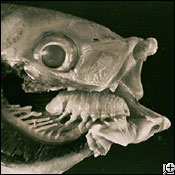
Fish Tongue-Eating Parasite Spreading?
By Jennifer Viegas, Discovery News
type size: [A] [A] [A]
Sept. 15, 2005 — A tongue-eating parasite inside the mouth of a red snapper purchased from a London fishmonger recently revolted its buyer and fascinated scientists.
Previously, scientists believed fish infected with the parasite, nicknamed the "tongue louse," existed solely in the Gulf of California. The find in England suggests the parasite's range may be expanding, according to a recent press release issued by a museum in England.
The parasite, Cymothoa exigua, attached itself to the host fish's tongue and snacked on it to the point where it replaced the missing part of the tongue. The parasite, which does not harm humans, only appears to feed on snapper, Luttjanus guttatus.
The stomach-churned diner who made the discovery contacted the Lewisham Borough Council, which sent the fish to Jim Brock, a leading British entomologist who is keeper of natural history at the Horniman Museum in London.
Brock said, "I have not seen this species in all my 13 years at the museum, so it's a remarkable find. This crustacean is considered in the scientific community to be the first known case of a parasite that actually replaces an organ of its host."
Brock and his colleagues have not yet ruled out that the fishmonger imported the infected fish from California, but he and other experts suspect that the parasite's range may be much wider than previously thought.
Matthew Gilligan, professor of marine sciences at Savannah State University in Georgia, told Discovery News he believed the tongue-eating animal is much more widely distributed than scientists suspected.
Gilligan said the insect is an isopod crustacean, which means that it's shell-covered, leggy and segmented. Other more common isopods include sowbugs and pillbugs. The group dates back at least to the Carboniferous Period of the Paleozoic, approximately 300 million years ago.
While tongue eating and replacing is unique to this particular species, he thinks the behavior probably evolved out of trial and error.
"They (parasites) are always testing the envelope on what they can get away with," Gilligan said. "Killing the host is self-destructive — maladaptive in evolutionary terms — but it is remarkable how much host damage can be inflicted by parasites while not severely impacting survivorship of the host."
The snapper needs its tongue to process food, but Gilligan said "an isopod tongue is more useful than no tongue at all."
Brock explained that the louse enters through the fish's gills using claws. It attaches itself to the base of the snapper's tongue and survives by drinking blood from a tongue artery.
"Eventually the fish's tongue is reduced to a stub," Brock said. "However, the parasite by now is large enough to replace the tongue and as it manipulates the fish's food, it also dines out for free on food particles when the fish eats."
The red snapper with the parasite soon will be on exhibit at the Horniman Museum.


1 comment:
Why did I read that? That's just gnarly... snapper... eeesh. Just gnarly.
Post a Comment